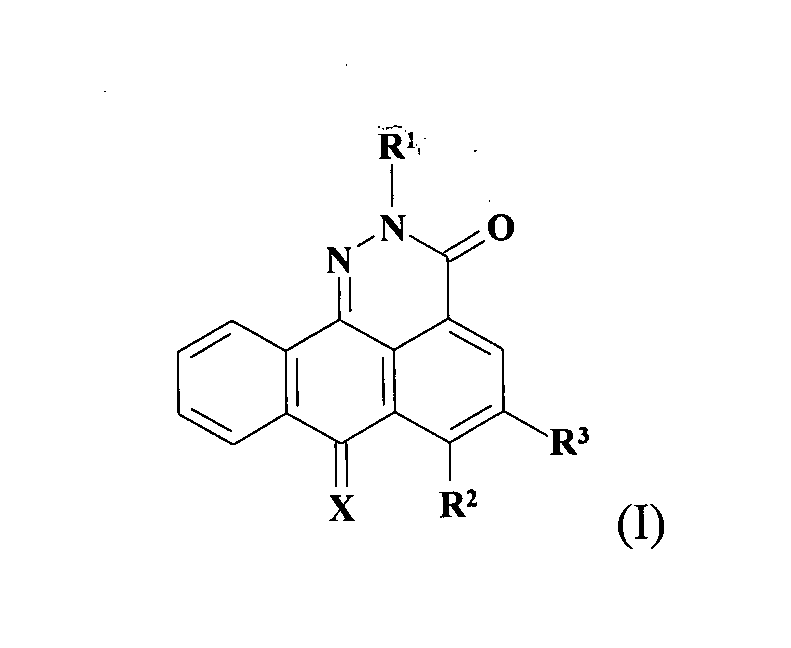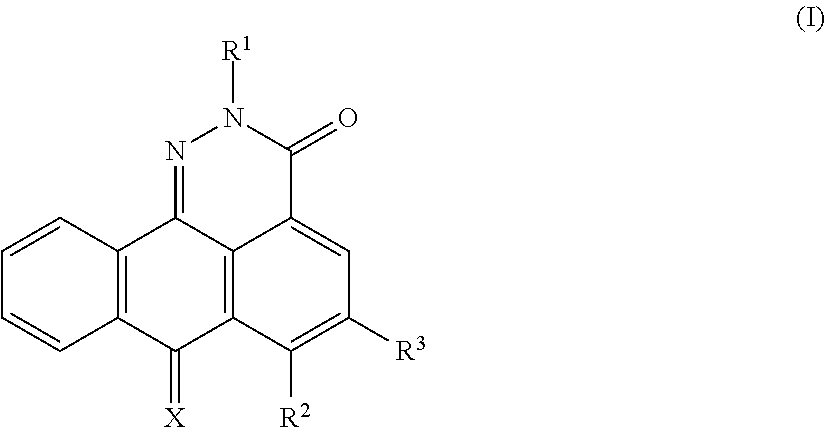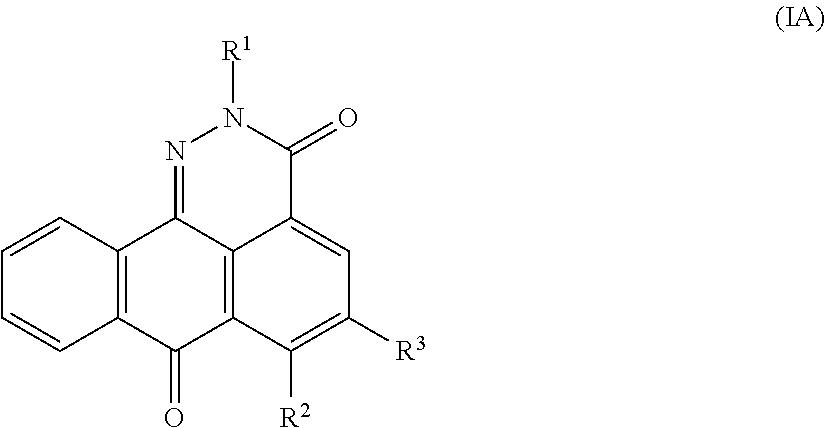Asymmetrically substituted anthrapyridazone derivatives as cytostatics
a technology of anthrapyridazone and derivatives, applied in the field of asymmetrically substituting anthrapyridazone derivatives as cytostatics, can solve the problems of loss of therapeutic efficacy of antitumor drugs, poor effect of these studies, and few other antitumor drugs shown to be rather poor substrates for mdr pomps
- Summary
- Abstract
- Description
- Claims
- Application Information
AI Technical Summary
Benefits of technology
Problems solved by technology
Method used
Image
Examples
example 1
[0156]2-[2-(Dimethylamino)ethyl]-6-chloro-2,7-dihydro-3H-dibenzo[de,h]cynnoline-3,7-dione
[0157]A suspension of 1-chloro-4-methylanthraquinone (6 g, 23.37 mmol) in the mixture of 12 ml 65% nitric acid and 24 ml of water is heated in the pressure reactor with teflon lining[0158]200° C. for 6 hours. The reaction mixture, after cooling, is diluted with water and the resulting precipitate is filtrated. The obtained crude acid is treated with chloroform, filtered and next crystallized with ethyl acetate to give 4.1 g (61% yield) of 4-chloroanthra quinone 1-carboxylic acid.
[0159]1H NMR (acetone, 200 MHz) δ 7.46 (d, 1H, J=8.4 Hz); 7.91 (m, 2H); 7.98 (d, 1H, J=8.4 Hz); 8.26 (m, 2H). MS-FAB m / z (relative intensity, %): 285([M]+, 100%).
[0160]To a suspension of 4-chloroanthraquinone-1-carboxylic acid (2.5 g, 8.74 mmol) in 30 ml of toluene 2.2 g of phosphorus pentachloride is added and the reaction mixture is stirred for 30 minutes to obtain clear solution. Next, to the solution, 1.5 ml of triet...
example 2
[0162]2-[2-(Dimethyloamino)ethyl]-6-{[2-(methylamino)ethyl]amino}-2,7-dihydro-3H -dibenzo[de,h]cynnoline-3,7-dione (BS-154), dihydrochloride
[0163]Solution of 50 mg (0.14 mmol) of 2-[2-(dimethylamino)ethylo]-6-chloro-2,7-dihydro-3H-dibenzo[de,h]cynnoline-3,7-dione and 1 ml of N-methylethylenediamine in
[0164]2 ml of pyridine is stirred at 60° C. for 30 minutes under nitrogen atmosphere. The progress of the reaction is monitored by thin layer chromatography on Silica Gel 60 (Merck) in chloroformmethanol (5:1) solvent system. The reaction mixture is diluted with chloroform and, to remove excess of amine, is carefully washed with diluted solution of hydrochloric acid and next with water. The organic layer is dried over anhydrous sodium sulphate, the solvent is evaporated under reduced pressure. The residue is purified by column chromatography (Silica gel, Merck, −200 mesh) in the solvent system successively: chloroformmethanol 10:1; 5:1; chloroform-methanol-25% solution of ammonia 5:1:0....
example 3
[0167]2-[2-(Dimethylamino)ethyl]-6-[2-(aminoethyl)amino)-2,7-dihydro-3H-dibenzo[de,h]cynnoline-3,7-dione (BS-121), dihydrochloride
[0168]Solution of 50 mg (0.14 mmol) of 2-[2-(dimethylamino)ethyl]-6-chloro-2,7-dihydro-3H-dibenzo[de,h]cynnoline-3,7-dione and 0.5 ml of 1,2-diaminoethane in 1 ml of pyridine is stirred at 80° C. for 1 hour under nitrogen atmosphere. The progress of the reaction is monitored by thin layer chromatography as in Example 2 in chloroform-methanol-25% solution of ammonia (5:1:0.1) solvent system. Subsequent procedure is analogous to that described in Example 2.
[0169]2-[2-(Dimethylamino)ethyl]-6-[2-(aminoethyl)amino)-2,7-dihydro-3H-dibenzo[de,h]cynnoline-3,7-dione (BS-121) is isolated on column chromatography as described in Example 2 in the solvent system, successively: chloroform-methanol 50:1; 20:1; 10:1; 5:1, then chloroform methanol-25% solution of ammonia 5:1:0.1.
[0170]The compound is converted into its dihydrochloride as described in Example 2. Yellow pow...
PUM
| Property | Measurement | Unit |
|---|---|---|
| resistance | aaaaa | aaaaa |
| multidrug resistance | aaaaa | aaaaa |
| multidrug cross resistance | aaaaa | aaaaa |
Abstract
Description
Claims
Application Information
 Login to View More
Login to View More - R&D
- Intellectual Property
- Life Sciences
- Materials
- Tech Scout
- Unparalleled Data Quality
- Higher Quality Content
- 60% Fewer Hallucinations
Browse by: Latest US Patents, China's latest patents, Technical Efficacy Thesaurus, Application Domain, Technology Topic, Popular Technical Reports.
© 2025 PatSnap. All rights reserved.Legal|Privacy policy|Modern Slavery Act Transparency Statement|Sitemap|About US| Contact US: help@patsnap.com



